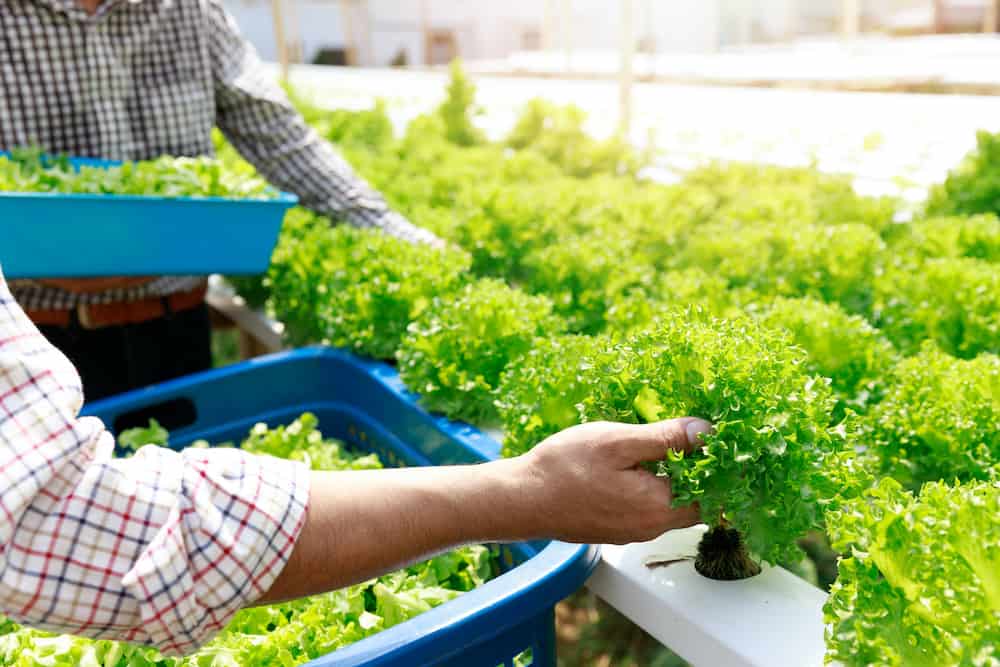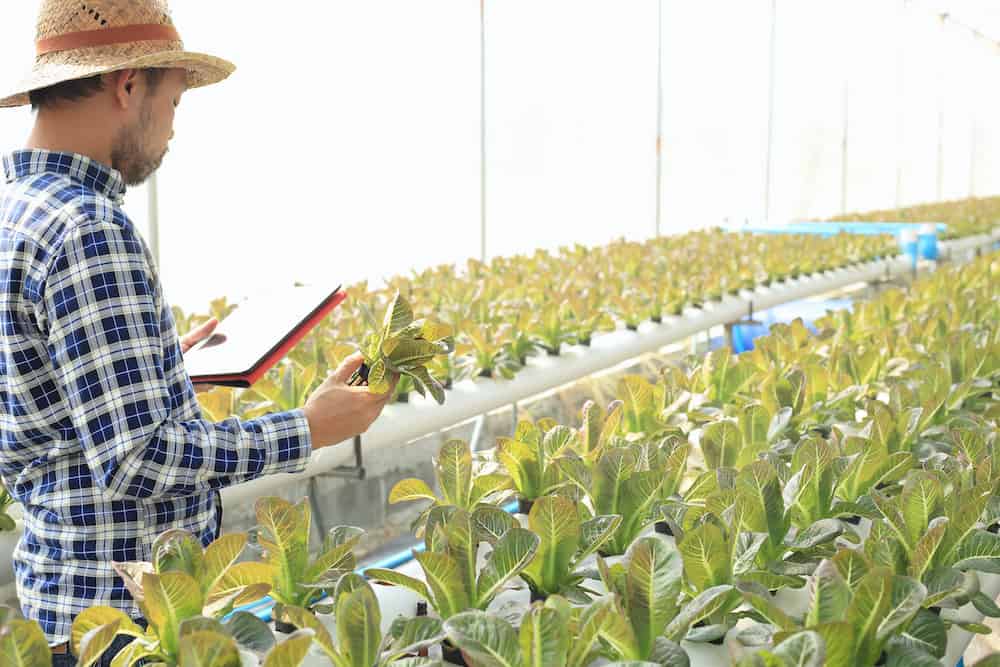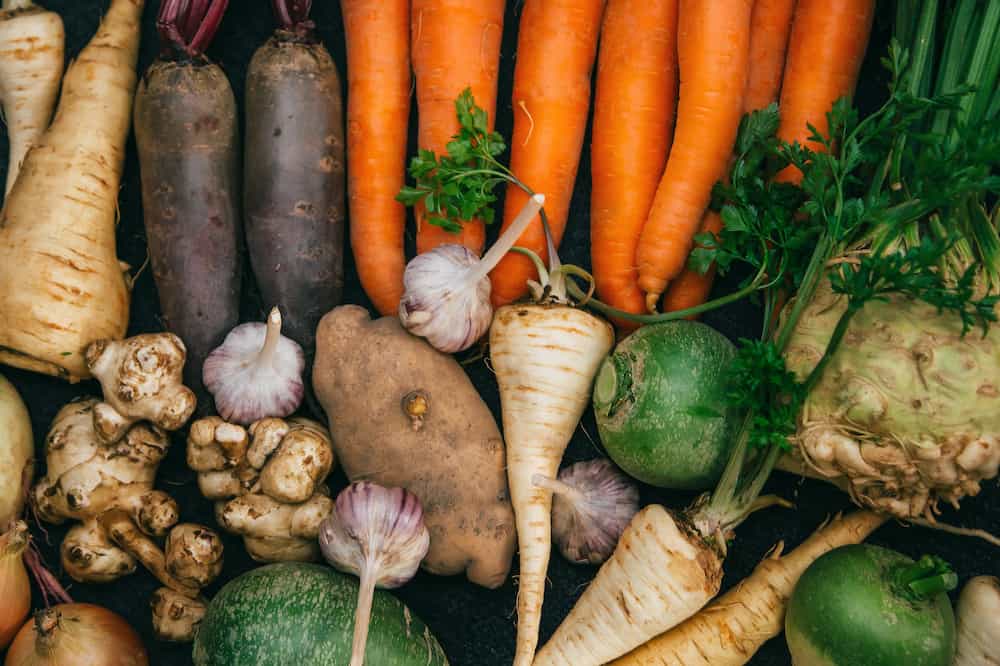Learning what cannot be grown hydroponically can help you create the most successful garden possible. With hydroponics, it’s important to know what you shouldn’t try to grow. Some plants are more delicate; others take too long to grow.
While you can grow most anything hydroponically, some plants will take more effort than it’s worth.
When you invest time, money and an area for hydroponic gardening, you want to take advantage of the space you have. You want to choose compact crops. Some fruits and vegetables will take up too much space which makes them less suitable for hydroponics.
Many species work well with hydroponic setups, as long as you know how to give them the support they need.
Worst Plants for Hydroponics
Any horticulturist can grow any type of plant with a hydroponic setup, but not all plants will provide the highest yield. Unlike traditional soil farming, hydroponics requires a particular type of plant to be the most successful.
The plants you should avoid include vining plants. Other plants you might not want to grow in hydroponics are bush types such as squash and zucchini. Vining and bush types of crops take up a lot of room and can take over the area.
Corn is another you shouldn’t grow in hydroponics because of its height.
The plants to choose are typically ones with shallow root systems and plants that are known for reproducing.
What Cannot Be Grown Hydroponically
Here are a few of the worst plants to grow in hydroponic gardens. Again, you can grow anything in hydroponics, but should you? That is for you to decide given the amount of space, time and money you have, as well as the reason you want to grow hydroponically.
If you really want to grow something, go for it. However, here is what we recommend you don’t grow. Some reasons you wouldn’t want to grow these foods in hydroponics is because:
- The space the plants and/or roots take
- Not cost effective to do so
- Time to grow hydroponically vs in soil or other medium
Potatoes and Sweet Potatoes
Traditional culture is the best option for potatoes and sweet potatoes, especially since they require soil to mature quickly and healthily.
Growing potatoes in soil is also substantially more cost-effective than growing them hydroponically. There are ways to grow potatoes hydroponically, but it will take a lot more effort and time than using soil.
Also, since potatoes and sweet potatoes have extensive root systems, they simply fare better in an in-ground environment.
Large Root Vegetables
Like potatoes, you’ll want to avoid using large root vegetables in your hydroponic garden. Some of the ones to avoid growing hydroponically are root vegetables such as turnips, onions, garlic, carrots, and rutabaga.
Typically, these species will need plenty of soil for their roots to spread out in search of nutrients and moisture. In a hydroponic setup, you need to continually monitor your plants’ growth and make sure their roots are nourished. It is possible to grow root vegetables hydroponically but it requires more effort.
Since the root systems are quite extensive, they are bound to take up a lot of your garden space. You’ll be allocating far a lot of area for their development, which takes away the most substantial benefit for hydroponic gardens… which is that it’s space-saving.
Corn
If you’re on a mission to develop a successful hydroponic garden, you will want to opt for the most cost-effective crops to grow. One of the benefits of growing foods with hydroponics is that you can take advantage of the fact that it’s vertical farming.
Unfortunately, corn isn’t one of the vegetables that you should set your sights on because of the amount of space it requires. It’s not possible to grow a substantial amount of corn without investing in an extensive system to do so. If you want to grow a few ears to try it, it is possible.
However, corn is one of the worst crops to grow hydroponically. You will need enough overhead space. In addition, it will be difficult to grow something above a row of corn stalks.
As delicious as corn is, it will require a large amount of garden area that most at-home hydroponic gardens don’t offer.
Vine Crops
Once you begin to do a substantial amount of research into hydroponics, you’ll find that some vine vegetables do well. For example, tomatoes and cucumbers are two vine plants that fare quite well in hydroponic setups, especially cherry tomatoes.
Unfortunately, there are other vine crops that you might want to consider avoiding due to their size. Like potatoes, vine crops have substantial root systems that will consume most nutrients from your reservoir.
If you intend to plant multiple species together, you’ll find the vine crops will drain the other plants’ nourishment.
You will also need to continually change trellising to ensure it’s at the correct height for the size of the vines. You’ll want to train them upward so they don’t sprawl horizontally as they would in a traditional garden.
Another important aspect of attempting to grow vine crops is to make sure the lighting is adjusted continuously.
It’s possible to grow plants such as peas and hops hydroponically, but your time investment may outweigh your investment return.
Melons
If you’re choosing plants for the first time for hydroponics, you want to choose plants that are easy to manage. Melons grow well in hydroponic gardens, especially watermelons which are water-based, but they’ll require additional support due to their weight.
Typically, you’ll have to design a reinforced trellis to ensure the plant can grow adequately without falling. You may also have to dedicate an entire section of your system to melons to nourish them adequately.
For beginners, this task can be quite labor-intensive, although it could be a phenomenal learning experience.

- Choose plants that don’t take up a lot of space.
Best Plants for Hydroponic Setups
If you are a beginner, instead of focusing on the plants that you can’t grow in hydroponic systems, you can guarantee there are far more you can. With the right know-how and tools, any plant can be grown hydroponically, but some tend to fare better than others.
Learn the best plants for hydroponics. A few examples of the best plants for hydroponic setups include:
Lettuce (pH 6.0 to 7.0)
One of the best plants to grow for hydroculture is lettuce since it brings a lot to the table. By growing lettuce, you can learn a lot about how your plants’ root systems work without much effort.
You’ll find that this vegetable is one of the best for beginners because of how strong it is and how easily it grows. See our complete guide lettuce hydroponics. Another advantage is it doesn’t require pollinators. This means you set up the hydroponics garden indoors in a greenhouse and won’t need to hand-pollinate.
Lettuce has a shallow root system, making it perfect for hydroponics. You won’t have to worry about using guides for its growth. All you have to do is allow it to flourish while regularly changing the nutrient-charged solution.
With a grow time of approximately 30 days, you won’t have to wait before harvesting. You can use the leaves as they start to grow in. Even if you’re designing a for-profit garden, you’ll appreciate being able to harvest plenty of lettuce to sell or trade.
A few of the most popular varieties include Boston, Iceberg, Buttercrunch, Romaine, and Bibb.
Strawberries (pH 5.5 to 6.2)
Most of the online tutorials you’ll find for hydroponics for beginners will have strawberries on their list. Strawberries are a phenomenal starter fruit that can grow during any season, especially if you have a greenhouse.
Fortunately, you’ll always have ready-to-eat strawberries throughout the year, making them easy to sell during the off-season. Once you have your strawberries set, harvesting is particularly simple without having to replant the plants.
Fortunately, they work quite well with one of the most common hydroponic setups: ebb and flow. You might also be able to see enough growth by using deep water culture or nutrient film technique.
Strawberries can take up to 60 days to grow if you’re working with cold-stored runners. It’s far better to opt for runners since strawberry seeds can take years to become fruit.
Some of the most popular strawberry varieties to grow include Tioga, Chandler, Red Gauntlet, and Brighton.
Spinach (pH 6.0 to 7.5)
When there are so many plants that do well, it makes sense to avoid the plants that aren’t as suited for hydroponics growing. Similar to lettuce, spinach is a plant that works exceptionally well in hydroponic gardens.
You’ll mostly want to use nutrient film technique for these plants since it allows for optimal oxygenation.
If budget isn’t a concern, aeroponics is also something to consider when working with spinach. One of the most considerable advantages to growing this plant is the reduced amount of water you’ll need to use.
You can also start growing spinach straight from seeds, which makes it even more cost-effective for beginners.
Be sure to keep an eye out for the following varieties: Catalina, Smooth Leafed, Bloomsdale, Regiment, Savoy, and Red Cardinal.
Bell Peppers (pH 6.0 to 6.5)
Bell peppers have a fantastic crispy texture and an unforgettable flavor, which makes them ideal for hydroponics. Although they can take up to 90 days to mature, they are well worth the wait because hydroponically grown varieties are the freshest.
You’ll find that ebb and flow systems are ideal for peppers, as is deep water culture. These two systems help to ensure the roots get substantial nourishment. Learn about ebb and flow hydroponics.
You need to give them 18 hours of light per day using LED grow lights, making sure the plants are six inches away.
Cherry Tomatoes (pH 5.5 to 6.5)
Cherry tomatoes are the most available type to work with hydroponically, especially as a beginner. You’ll mostly find these plants in more mature gardens because they require extra care. Like cucumbers, once you understand your hydroponics system, they’re great to diversify your garden.
The best option for growing tomatoes is to rely on cuttings rather than seeds that tend to grow slower. Learn how to grow hydroponic tomatoes.
Apart from needing trellises to ensure your plants can grow a steady stream of tomatoes, you also need to consider pests.
Tomatoes are particularly susceptible to aphids, spider mites, and other harmful pests that could destroy your garden. You will need to take special care to maintain the environment to ensure they don’t get diseases.
Choosing Easy-to-Grow Plants
With so many fruits and vegetables that do so well growing in hydroponics, it is best to start with ones that do well so you will be successful and can maximize your harvest. This is especially important if you are a beginner.
Also choose plants that grow vertically instead sprawling horizontally to maximize the space in your garden. One to consider is pole beans as they grow vertically.

What Are the Problems with Hydroponics?
There are many common mistakes beginners make with hydroponic gardens. This is why it’s important to know what cannot be grown hydroponically. (Again, you can grow most anything in hydroponics. However, some things are not worth the investment of time, space, money and energy to do so.)
The top mistakes that beginners might experience with their hydroponic systems include the following:
Ignoring pH
To ensure whatever you plant hydroponically is successful, you’ll need to monitor the pH. One of the essential parts of any hydroponic system is the pH level of the water.
Your plants are particularly susceptible to changing levels, so certain fruits and vegetables have differing pH needs. If the pH isn’t balanced, it could mean the nutrient solution is either too acidic or too alkaline, causing nutrient deficiencies.
If the pH is off for a specific species, the plants could die, so you need to monitor them regularly.
With the help of a pH meter, you can check the levels daily to determine if you need to balance the solution. Considering all of the plants in your garden will survive off the same nutrient solution, testing this regularly is imperative. You can usually find a pH meter for hydroponics at gardening centers, nurseries, some home improvement stores, and online at stores such as Home Depot, Lowes, Target, Walmart, and Amazon.
In time, as you gain more experience, you will set up a general hydroponics feeding schedule.
Lacking lighting
It’s far too often that starter-horticulturists believe interior lighting is substantial enough for plants when it isn’t.
Remember, if the hydroponic garden is indoors, the plants will need access to the sun. You’ll want to ensure you invest in grow lights to allow the garden to flourish.
It’s also essential to ensure you’re spending money on high-quality the best hydroponics equipment, such as bulbs. Otherwise, your lighting kits won’t perform properly, preventing your plants from thriving.
You should spend some time looking into the specific type of LED grow lights that work best for your crops based on their energy. For example, peppers require plenty of light for up to 18 hours per day. They also need to be placed close to the light.
Without sufficient lighting, your plants won’t thrive.
Forgetting to sanitize
Once you finish setting up your hydroponic system, it can be easy to assume it’s self-sustaining and requires little maintenance.
Unfortunately, hydroponics differs significantly from traditional soil farming in this aspect. You will need to spend a substantial amount of time disinfecting your garden to prevent diseases and pests. For example, you will need to disinfect the reservoir before switching the nutrient-rich solution.
A few other examples of critical sanitary tasks include:
- Disposing Plant Waste: By getting rid of excess plant waste, you can prevent pests’ prevalence. Also, rotting cuttings can cause disease among your gardens.
- Sterilizing Containers and Tools: It’s important to ensure you don’t promote cross-contamination with your plants. By sterilizing containers and tools, you can have clean equipment to use for each plant.
- Maintaining Clean and Dry Floors: Floors are likely the dirtiest part of your indoor garden. It’s important to keep them clean and dry for your safety and your plant’s safety. By eliminating excess dirt, you can prevent hazards and bacterial growth.
Avoiding advancements
The fundamentals of hydroponics don’t change, but there’s always new technology. It’s important to remember that this method of gardening has boomed in popularity recently.
Meaning, there are bound to be many substantial improvements to experience. Although you may already know how your system works, you should always diversify your knowledge.
In the future, hydroponics could be far more popular than traditional soil farming, and you’ll want to be prepared. There are hundreds of online resources to consider, and you can find plenty of guidance from other hydroculture enthusiasts.
The more you implement new technologies in your garden, the faster your crops will grow. In addition, they may be more nutrient-dense, and they will provide a greater yield.
You might even be able to qualify for government grants and other exceptional opportunities when growing with hydroponics.
FAQ’s About Choosing What to Grow in Hydroponics
Can All Plants Be Grown Hydroponically?
While most all plants can be grown hydroponically, it doesn’t mean you should grow them. The advantages of growing this way means you can maximize yields quickly and with less space than traditional gardens.
Knowing what cannot be grown hydroponically is helpful so you can make the best use of your resources, including time and space.
Can Corn Be Grown Hydroponically?
You can grow corn hydroponically but that doesn’t mean you should. Corn grows tall; you will need to ensure you have the vertical space available for corn stalks.
In addition, you will yield just one ear per plant. There are other things you can grow in which you can continue to pick and enjoy. With many fruits and vegetables, you will have a harvest for several months or longer.
Can You Grow Potatoes Hydroponically?
Yes, you can grow potatoes hydroponically. One of the best hydroponic methods to grow potatoes in is the aggregate method.
Can You Grow Carrots Hydroponically?
You can grow carrots in hydroponics. They will grow well in an ebb and flow hydroponics system.
What Cannot Be Grown Hydroponically?
When figuring out what can’t be grown hydroponically, only a few types of crops won’t grow well. While it’s true you likely can grow anything, it’s typically not worth it to try given the amount of detail you will need to spend to make the plants successful.
When growing hydroponically, avoid fruit and vegetable plants that take up too much room. Also avoid root vegetables which grow underground. While you can grow root vegetables in hydroponics (think hydroponic root vegetables such as hydroponic beets, potatoes, carrots, etc.) there are better options. These aren’t the best suited for hydroponic growing.
Yes, with lots of time and effort, you can grow most any crop. However, the advantage of hydroponics is the compact space so avoid growing plants that take up a lot of room or don’t grow as well. The great news is there are many crops that you can grow successfully, even if you are a beginner. Plants to grow hydroponically include the easiest ones to grow. Learn more about what fruits can be grown hydroponically.
See related:


Why do you claim subsoil vegs can’t grow in hydroponics? Everything can grow in Hydro or aquaponics. Even patatoes.
The only thing is what can be defined as hydroponics?
All growing processes that is mainly watergrowing IS hydroponics.
Thanks for writing about growing these types of vegetables in hydroponics. We included these vegetables as not being as productive as others — but yes, you can grow them and most anything! We are writing from the perspective of it being as “worth” it for the time, money, and space vs other vegetables and fruits.